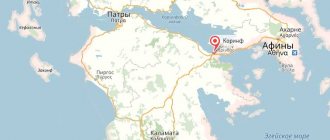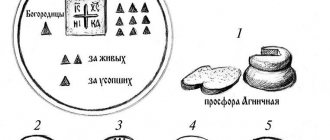THOMAS
We analyze the most noticeable “inconsistencies”.
The attentive reader of the Gospel of John will be greatly surprised when he sees how many points there are in it that seem to be completely at odds with the stories of the other three evangelists. The article examines the most mysterious of these “discrepancies.”
Why do John's future apostles meet Christ in a completely different place?
In fact, it may seem that there is no unity in the story of the apostles’ acquaintance with Christ even between the three evangelical “forecasters.” This is how in Greek (Greek σύνοψις means “joint review”) they call Matthew, Mark and Luke, whose stories fit together well and complement each other.
For example, the Apostle Luke recalls how Christ preached to the people gathered on the shore of Lake Gennesaret, standing in a boat that He borrowed from Peter. He thanked Peter and his companions - James and John - with an unprecedented catch of fish, and then called for Him (Luke 5:1-11).
Matthew and Mark tell a slightly different story - how, passing by this lake, Jesus saw first Peter and Andrew casting nets into the sea, and then James and John mending their nets in a boat together with their father Zebedee, and called both ( Matthew 4:18–22, Mark 1:16–20).
But the Apostle John has a completely different story. First, Andrei and one of his comrades meet Christ (most likely, it was the narrator himself - John: this was the opinion, for example, of the professor of the St. Petersburg Theological Academy Alexander Pavlovich Lopukhin). Both at that time were disciples of John the Baptist, and it was he who pointed them to Jesus. After spending the day with Jesus, Andrew finds his brother Simon - the future Peter - and brings him to Jesus, saying: “We have found the Messiah, which means: Christ.” And then Jesus Himself calls another of their comrades, Philip, who takes his friend Nathanael with him: “We have found the One about whom Moses in the law and the prophets wrote.” Nathanael is skeptical, but then it is revealed to him that Jesus is the true Son of God, and he joins His disciples (John 1:35-51)…
All these events are so different that they even take place in different places! Lake Gennesaret is Galilee, northern Palestine. And Bethavara, where John the Baptist preached, is in Judea, on the banks of the Jordan River.
Doesn't one fit with the other? And it shouldn’t - the evangelists are simply talking about different events that happened at different times. The first acquaintance of the future apostles (or rather, some of them) with Jesus took place thanks to John the Baptist and occurred even before Jesus, seeing them on the shore of a lake in Galilee, called them to follow Him. It must be said that this looks much more reliable than the idea that the Galilean fishermen rushed after Christ as soon as they first saw Him.
Well, the final call to the apostleship followed, apparently, after that same miraculous fishing, after which Peter and the other disciples abandoned their previous occupation forever.
Why are the names of the apostles in the Gospel of John different from those of the other evangelists?
Even the first three evangelists have slight discrepancies in the names of the apostles. For example, Matthew and Mark talk about Simon the Zealot, and Luke talks about Simon the Zealot. It is clear that they mean the same person: the nicknames “Kananit” and “zealot” mean the same thing - “zealot”, just the first word is Aramaic, and the other is Greek. Another example is Levvy Thaddeus: this apostle bears such a name only in the Gospel of Matthew; in Mark he is simply Thaddeus, and in Luke he is Judas Jacob.
The fact is that one person in those days often had several names at once. For example, the supreme apostle received the Greek name Peter from Christ Himself, and in “ordinary life” he was called Simon. The Apostle Paul's name before he went on missionary journeys was Saul (Acts 13:9), one of his companions, Barnabas, was Josiah (Acts 4:36), and the other, Mark, was John (Acts 12:25). .
John the Theologian is the only one of the evangelists who does not list the names of all twelve apostles. He does not want to repeat himself, because he writes his Gospel last of the four, when the other three have already been written down, and his goal is only to add. Only eight disciples appear in John: Simon Peter, Andrew, Philip, “the two sons of Zebedee,” including “the disciple whom Jesus loved,” “Thomas called the Twin,” Judas Simon Iscariot and Nathanael. All interpreters unanimously believe that Nathanael is the first and “main” name of the Apostle Bartholomew, because the Aramaic Bartholomew is more of a patronymic: the son of Falome. In the same way, Peter is called in the Gospel “Simon, son of Jonah,” and the disciple who betrayed Jesus is “Judas Simon Iscariot.”
Who and when were the Gospels written?
In the 20s of the 19th century, Christian Bauer, a theologian at the University of Tübingen, suggested that the Gospels were written at the end of the 2nd century. Mythologists happily seized on this idea; It is also supported by many who believe in the “historical core” of the Gospels. They argue that for this reason, New Testament writing cannot provide reliable information about the life of Christ /128/. Is it so? And what do we know today about the origins of the Gospels?
The originals of the Gospels have not survived, but in this they are no exception among the majority of works of ancient authors. The originals of the books of Seneca, Flavius, Tacitus and other writers of the 1st-2nd centuries have been lost. Therefore, there are two ways to date such works:
1) according to the earliest available manuscripts;
2) according to the earliest references to these works in the works of authors whose lifetimes are more accurately dated.
In terms of manuscripts, the Gospels compare favorably with the rest of ancient literature. If there are, for example, 11 manuscripts of the works of Plato, 50 of Aeschylus, 2 of Euripides, 10 of Virgil (all of these, of course, are lists, not originals), then the New Testament writing is represented by Greek manuscripts in an amount exceeding 2500 copies.
But the advantage of the Gospel will be especially significant if we bear in mind the period that has passed from the time of the writing of the book to the earliest surviving manuscript. The originals of Virgil are 400 years distant from the most ancient copies of his works, Horace - 700 years, Julius Caesar - 900 years, Plato - 1300 years, Sophocles - 1400 years, Aeschylus - 1500 years, Euripides - 1600 years, Gospel manuscripts are separated from the original by a gap of only a few decades
.
It is known, in particular, that the latest was the Gospel of John (the time of its writing dates back to the 90s), and the most ancient passage from this Gospel, found in Egypt, dates back to 120-125 years. A fragment of the Gospel narrative was also discovered, the compiler of which already knew all four canonical Gospels. It dates from the end of the 1st or beginning of the 2nd century. A papyrus published in 1955, which includes half of the Gospel of John/129/, dates back to the year 200.
If we turn to references to the Gospels from writers of the 1st and 2nd centuries, we will find many of them. Here are some of them /130/:
St. Clement of Rome
Around the year 95 he writes a letter in which he quotes words from the Gospels of Matthew and Mark/131/.
St. Ignatius of Antioch
, executed in 107, quotes the Gospel of Matthew.
Apparently, from an environment close to Ignatius came the work Didache
, or the Teaching of the Twelve Apostles (c. 100). It contains phrases from Matthew and Luke, and in one place there is a direct reference to the “Good News”, i.e. Gospel/132/.
St. Polycarp of Smyrna
, a disciple of the Apostle John, when he was condemned to death in 156, said that he had served Christ for 86 years. Consequently, he also saw the Jewish War of 66-70. In his letter, Polycarp quotes the Gospels of Matthew and Luke and 1 John/133/.
Disciple of St. John and friend of Polycarp, Papias of Hierapolis
(c.70-150) tells in detail how the Gospels of Matthew and Mark were written. He drew his information from people who personally knew Christians of the first generation. In particular, he knew the daughters of Philip, one of the Twelve. Around the year 130, Papias compiled the book “Interpretation of the Lord’s Sayings,” in which he wrote:
“Unlike many, I trusted not those who were verbose, but those who conveyed not the thoughts of others, but the commandments given to believers by the Lord and flowing from the Truth itself. If, for example, I met a person who was a disciple of the elders, I asked about the conversations of the elders themselves: what Andrew, or Peter, or Philip, or Thomas, or James, or John, or Matthew, or any other of the disciples of the Lord said, what Aristion and Presbyter John, the disciples of the Lord, said”/134/.
The Christian writer Aristides in his “Apology” (c. 120) already calls the Gospels Holy Scripture/135/.
St. Justin the Philosopher
, a native of Palestine, who converted to Christianity around 130 and was executed for his profession in 163, cites excerpts from three Gospels, calling them “memoirs of the apostles,” as well as some unknown works close to the canonical Gospels/136/.
Around 170 the Syrian Tatian
compiled a compilation
of all four Gospels
, thereby showing that he considers them generally accepted and canonical. In 1935, excerpts from his work dating back to the year 200/137/ were found.
Contemporary of Tatiana St. Irenaeus of Lyon
(120-200) not only speaks of the four Gospels, but also names their authors. The testimony of Irenaeus is especially valuable, since in his youth he personally knew Polycarp of Smyrna.
“I remember that time more firmly than the recent one,” he wrote to his friend Florin of his youth, “for what we learned in childhood is strengthened along with the soul and takes root in it. Thus, I could even describe the place where blessed Polycarp sat and talked; I can depict his gait, his lifestyle and appearance; his conversations with the people, how he talked about his communication with John* and others who saw the Lord, how he recalled their words and retold what he heard from them about the Lord.” ————————————————- * We are talking about the Apostle John.
And, according to Irenaeus, everything that Polycarp said was in accordance with the Gospel/138/.
The list of New Testament books discovered in 1740 by the Italian scientist Muratori and named after him the “Muratorian Canon” dates back to the era of Irenaeus.
Even from these few examples it follows that from the very beginning of the 2nd century the Gospels, and mainly the canonical ones, were widely known.
What information exists about the authors of the Gospels?
In ancient times it was the custom to attribute books to great sages and thereby reinforce the authority of the text. Many works appeared that allegedly belonged to Enoch, Moses, Solomon, etc. Critics of the Gospels tried to use this fact to question their historical value. But the question arises: why are the authors of our Gospels named not the apostles closest to Christ - Peter, James, Andrew, but such seemingly minor persons as Mark or Luke? And Matthew was not a man who played a prominent role among the apostles.
The titles of the Gospels contain not just the names of their authors, but they are called “Gospel according to (kata) Matthew”, “Mark”, “Luke”, “John”. The word kata in this case means that the book was written “according to such and such an author” or “according to such and such an author.” Some critics see this as evidence of the inauthenticity of the Gospels. However, in Greek literature the word kata is often used to denote direct authorship/139/. In addition, the use of the word kata also has a certain theological meaning. The Gospel is the teaching of Christ Himself, and the evangelists give only its exposition. Therefore, to say, for example, “Luke’s Gospel” would be essentially incorrect. In reality, this is the “Good News of Jesus Christ” according to Luke, according to Mark, etc.
It is argued that the Gospels, works of high literary skill, could not have been written by “illiterate fishermen.” But, on the one hand, we know many examples of how wonderful works came from the pens of people who did not receive a wide education; Thus, Jacob Boehme, the great thinker of the 17th century, was a shoemaker. On the other hand, it is incorrect to call the evangelists “illiterate fishermen”: Matthew was a tax collector, Mark came from a priest’s family, Luke was a doctor, John was close to the highest circles of Jerusalem society.
Early Christian tradition unanimously connects the Gospels with those persons whose names appear in their titles. Let's start with the Gospel of Mark
, since it is considered the earliest.
John-Mark belonged to a Christian family living in Jerusalem and close to the Apostle Peter. He was a relative of Joseph Barnabas, a friend of St. Peter. At one time, Mark accompanied the “apostle of the pagans” on his missionary travels, but later they separated, and the young man became the companion of Peter, who called him “his son.” The Galilean apostle needed a translator, since he did not speak Greek well, much less Latin. In the early 60s, Mark met again with the Apostle Paul, but in Rome. According to Irenaeus of Lyons, Mark wrote his Gospel shortly after the death of Apostle Peter, who was crucified around 64/140/. The disciple of the Apostle John, Papias of Hierapolis, cites the testimony of the disciple of Christ, Presbyter John:
“Mark, the interpreter* of Peter, accurately wrote down everything that he remembered, although he did not adhere to the order of the words and deeds of Christ, because he himself did not listen to the Lord and did not accompany Him. Subsequently, however, he was, as said, with Peter, but Peter expounded the teaching in order to satisfy the needs of the listeners, and not in order to convey the Lord’s conversations in order” / 141 /. ————————————————— * Literally - . . . . . , interpreter, translator.
It is significant that St. Justin, citing one passage from the Gospel of Mark, calls his source “Memoirs of Peter”/142/.
This information fits well with the nature of the Gospel of Mark itself. It looks like a collection of episodes, little connected with each other and placed without a strict chronological outline (with the exception of the beginning and description of the Passion of Christ). This can apparently be explained by the fact that the evangelist first wrote down separate stories for Peter, and later combined them.
There is an echo of the Semitic style in Mark's simple narrative. The writer is characterized by laconicism, common expressions, and swiftness. Scenes quickly follow each other. Moving from event to event, Mark repeats the word “immediately” many times. His vocabulary is poor, but surprisingly specific. Researchers counted in his book eleven terms denoting parts of the house, ten - parts of clothing, nine - types of food / 143 /.
Mark mentions not only details that eyewitness Peter could tell him, but also, apparently, personally known to the evangelist. For example, he alone talks about a certain young man who witnessed the arrest of Jesus. According to most interpreters, it was Mark himself. When the evangelist writes about Simon of Cyrene, who carried the cross of Christ to Calvary, he notes without any explanation that he was “the father of Alexander and Rufus.” Obviously, the author believed that these faces were well known to his readers. In the Epistle of the Apostle Paul to the Romans, a certain Rufus, a member of the early Christian community/144/, is actually mentioned.
According to tradition preserved by Clement of Alexandria, Jerome and Eusebius, Mark wrote the Gospel in Rome. This is confirmed by some Latinisms in the book/145/. In any case, it is certain that he had in mind readers who lived outside Palestine. Mark explains the meaning of the Aramaic words he cites almost everywhere /146/.
There are no direct hints in the Gospel that Jerusalem has already been destroyed. Consequently, it was written no later than the 60s of the 1st century.
If the Second Gospel relates mainly the events
life of the Savior, then in the first, bearing the name
Matthew
, much space is devoted to the words of Christ. The already mentioned Papias of Hierapolis testifies: “Matthew wrote down the sayings of the Lord (Logia Kiriaka) in Hebrew, and translated (or interpreted) them as best he could”/147/. This means that our Gospel of Matthew, written in Greek, is not the “Logia” of the original text. However, even in its current form it reveals an author closely associated with the Jewish-Christian tradition. Matthew makes frequent references to the Old Testament, uses the word “scribe” in a positive sense, attaches great importance to the community of believers, the Church, retains Palestinian expressions, does not explain the meaning of Jewish customs and the meaning of a number of Aramaic words /148/.
The narrative part of the Gospel of Matthew is largely borrowed from Mark, the text of which fits almost entirely into Matthew and Luke. Therefore, the most original part of the book should be considered the sayings of Jesus /149/.
Apparently, the “Logies,” or “Words of the Lord,” were not completely included in the Greek Gospel of Matthew. They could exist in the form of a collection of sayings, similar to those that were widespread in early Christian times /150/. However, it should be remembered that “dvarim”—the Hebrew equivalent of the word “logia”—meant both “words” and “deeds.”
Matthew’s “Logies were probably written even before the Jewish War, i.e. in the 40s or 50s, and the Greek version in the 70s. “Some researchers,” notes Karl Adam, “go even further and believe that the “Source of Speeches,” i.e. The main text of Matthew, written in Aramaic, was compiled during the life of Jesus, since it apparently did not yet mention the history of the suffering of the Lord and since everything suggests that Paul already knew and used this source. Since E. Littman established that the original Aramaic text of the Lord's Prayer is structured in tetrameters and end rhymes, it seems very likely that this rhythmic form was developed by Jesus Himself and that in the Aramaic text of the prayer we have “our own words Gentlemen in their original sound”/151/.
Author of the third Gospel Luke
, unlike Mark, is not an artless storyteller, but a writer who has already had before his eyes “many” attempts to expound the life and teachings of Christ /152/. He apparently was not a Jew; there is little Semitism in his book. He makes extensive use of the Gospel of Mark, but has other sources at his disposal. Some of them arose among Jewish Christians and even disciples of the Baptist.
Ancient tradition attributes to St. Luke - the physician and companion of the Apostle Paul - the compilation of the Acts of the Apostles/153/. And indeed, when this book talks about the joint journey of Paul and Luke, the author tells the story in the first person/154/. Acts is a continuation of the third Gospel, as explicitly stated in the preface. Therefore, this Gospel must also belong to Luke/155/. It is characteristic that the third Gospel emphasizes, as in the Epistles of Paul, the universal mission of Christianity.
One of the documents, which was written around 170, says the following about Luke:
“Luke, a Syrian, originally from Antioch, physician, disciple of the apostles; he later followed Paul until his martyrdom. Serving the Lord impeccably, he had no wife or children. He died in Boeotia, filled with the Holy Spirit, at the age of eighty-four. Since the Gospels had already been written in Judea by Matthew, in Italy by Mark, Luke, under the inspiration of the Holy Spirit, wrote the Gospel in the region of Achaia”/156/.
Even if not all the details given in this text are reliable, Luke was undoubtedly the first historian of Christianity, although his book does not coincide in genre with the historical works of ancient authors. According to most modern scholars, Luke wrote during the years of the Jewish War or even earlier, that is, between the 60s and 70s /157/.
The first three Gospels reveal great similarities in composition, and also have many literal coincidences. This became obvious after they were published in the form of a Synopsis
, i.e. parallel columns. Hence their generally accepted name - the Synoptic Gospels.
A comparative analysis of the texts also shed light on the dependence of the evangelists on each other. In general terms they can be presented as follows: Mark gave material to the Greek version of the Gospel of Matthew and Luke; The compiler of the Greek version of Matthew, in addition to Logia and Mark, had at his disposal some other written or oral source. The same source was used by Luke, who also drew from Logia/158/.
Scheme of the origin of the Synoptic Gospels
The Synoptic Gospels not only have common and similar texts, they have one important feature in common: the speeches of Jesus in them differ sharply in style from the words of the evangelists themselves. Obviously, these speeches were well preserved in the memory of the first disciples.
The Fourth Gospel is named after John
. According to legend, they would be none other than John, son of Zebedee. Belonging to the disciples of the Baptist, he was one of the first to follow Christ along with his brother and mother. For his ardor, John received from the Teacher the nickname “Son of the Storm”, or “Son of Thunder”. The Fourth Gospel calls John “the disciple whom Jesus loved.” It also says that he was the only one of the Twelve to be at Golgotha and after the death of the Lord he took His Mother to him. At that time he was only eighteen or twenty years old.
In the early 30s of the 1st century, John, together with Peter, preached among Jews and Samaritans, survived arrest, and after the execution of his brother James in 44, he probably left Judea. At the end of the century, he headed communities in Asia Minor and lived in the city of Ephesus. From Ephesus, John was expelled by the Roman authorities to the island of Patmos and returned there again. He died around the year 100 at a ripe old age /159/. According to Asia Minor legend, the apostle wrote his Gospel in the 90s.
Doubts were expressed whether John, at such an advanced age, could have created such a perfect work /160/. But if we remember that Sophocles finished his “Oedipus at Colonus” at the age of 89, Titian worked on the painting “The Descent from the Cross” as a 97-year-old man, and Goethe wrote the best scenes of the second part of “Faust” at the age of 83, then this objection disappears.
The Gospel of John differs in style from the Synoptics. The image of Christ in him is somewhat different than in Matthew, Mark and Luke. This, however, does not detract from the reliability of the book, but only indicates the personal properties of the author. After all, Socrates does not look the same in Xenophon as in Plato.
John, more than the weather forecasters, emphasizes that Christ is the Son of God who came from Heaven, but at the same time, it is John who, almost more often than other evangelists, highlights His human nature, speaking about Jesus’ humility before the Father, His friendly feelings, fatigue , sorrow, tears.
The Synoptic Gospels tell only about the ministry of Christ in Galilee, and then immediately move on to His final journey to Jerusalem. John speaks of Jesus’ repeated visits to Judea before Holy Week. Previously, historians were inclined to favor the chronology of the first three evangelists; however, confidence in John's testimony has now increased. The weather forecasters did not set themselves the task of giving a consistent image of events, but John obviously had this goal. It is difficult to imagine that Jesus, who from childhood went to Jerusalem on holidays, abandoned this custom during His ministry. In addition, we find two indirect evidence in Luke that confirms John. The evangelist says that Christ “preached in the synagogues of Judea” (Luke 4:44), and also describes the Lord’s visit to the house of Martha, which was located several kilometers from the capital.
John, more often than the synoptic authors, dwells on Jesus’ testimony about Himself. In relation to Him, the evangelist uses the word Logos
, well known in ancient philosophy. This feature of the IV Gospel gave rise to critics to believe that its author was a Greek writer close to the ideas of Gnosticism. However, subsequently the connection between the doctrine of the Logos and the Jewish concept of the Word as a form of Epiphany /161/ became obvious.
Philologists have established that the Gospel of John is the work of a man who, if not wrote, then at least thought in Aramaic. In some places it seems to be simply a translation from this language. Unlike the Synoptics, John quotes the Old Testament not from the Septuagint, but gives a translation from the Hebrew and Aramaic Targums /162/.
The discoveries at Qumran showed that the IV Gospel is closely related to Essene ideas and phraseology /163/. “From now on,” says Qumran researcher J. Allegro, an author very far from Christianity, “John cannot be considered as the most Hellenic of the evangelists, his “gnosticism” and the whole range of his ideas stems from Jewish sectarianism, rooted in Palestinian soil, and his material must be recognized as based on the early layers of the evangelical tradition/164/.
Charles Dodd, an expert on the Fourth Gospel, notes that this book is based on “an ancient tradition independent of the other Gospels, and deserves serious attention because it enriches our knowledge of the historical facts relating to Jesus Christ” / 165 /.
Moreover, if weather forecasters are compilers using various materials, then in the Gospel of John the hand of one author is visible everywhere. He is a master of dialogue and dramatic pictures, from which in some places it emanates the vivid memories of an eyewitness.
Nevertheless, one feature of the IV Gospel speaks against its belonging to the son of Zebedee. It speaks about John in such reverent tones, and so emphasizes the love that Jesus showed for him, that it is difficult to identify the author with the apostle himself.
The ancient icons of St. John also give us pause for thought. Unlike the weather forecasters, he is depicted everywhere as dictating
, not writers.
Recently, Raymond Brown put forward a hypothesis according to which Gospel IV is a record of the stories and sermons of the apostle. Later, it went through several stages of processing, while maintaining intact the basis of John's tradition/166/.
It is not yet possible to establish who made these recordings and the editing of the text. However, it is possible that they were completed by a certain John, who then lived in Ephesus. He was called a presbyter
, an old man. Perhaps the Epistles of John, the author of which also calls himself “presbyter,” were written by this man. The hypothesis about the “presbyter” is not contradicted by the words of the Epistle, indicating the direct participation of the author in the events of the Gospel. Indeed, according to the testimony of Papias, Prester John was one of the disciples who “saw the Lord,” although he was not part of the Twelve/167/.
It is significant that the tombs of both Johns, the apostle and the presbyter, were venerated in Ephesus.
Whether John himself wrote or the IV Gospel was compiled from his words, it is replete with accurate historical and geographical details that would have been unthinkable in a Greek author of the 2nd century. It was the instructions of the IV Gospel that led, as we will see below, to the successful results of excavations in Palestine /168/.
And finally, the discovery of a fragment from the Gospel of John in Egypt fully confirms the traditional date - the 90s. The papyrus was found among the belongings of a soldier who already had the IV Gospel around the year 120. Enough time must have passed from the writing of the book in Ephesus to this moment.
So, the four canonical Gospels were created during the second half of the 1st century, when many people still lived who personally knew Jesus Christ, that is, in the apostolic
era.
But nevertheless, the Gospels arose several decades after the events described in them, and therefore it is important to establish the original sources
of the evangelists. We have already named one of them - these are recordings of the speeches of Christ, in particular the “Logia” of Matthew. Can you say something about other sources?
The apocryphal gospels can hardly be considered such sources.
. They were rejected by the Church because they came from among heretics, which was fully confirmed by further study of these monuments. In addition, not a single apocrypha is known that would have appeared before the year 100. The attempt of the Russian writer and critic D.S. Merezhkovsky to find traces of the original legend in the apocrypha can hardly be called successful /169/.
According to two well-known experts, “the time has passed when they tried to see in apocryphal works the source of our canonical texts. Moreover, it is difficult to even imagine how this weed could arise and grow in the field of divinely inspired literature. It was simply the result of popular curiosity, prone to the unusual and greedy for details, and the eternal desire for a fairy tale” / 170 /.
There are separate sayings of Christ that are not included in the Gospels, the so-called agraphs
, which can be partially considered authentic. But, according to Joachim Jeremias, who carefully studied them, they provide only an addition to the four Gospels and nothing more. “The true significance of the extra-Gospel tradition,” he writes, “is that it clearly reveals the value of our Four Gospels” /171/.
Apparently, at first, oral stories about Jesus, which had a rhythmic form, became widespread among Christians. As has already been said, it is especially felt in the transmission of the speeches of the Lord. The Jews had long had the custom of memorizing large, coherent texts. There was even a special class of “Masoretes,” custodians of the Scriptures, who memorized the Bible and corrected the copyists. Something similar apparently happened in the early Church. Oral First Gospel
consolidated in various assemblies. And only in the middle of the 1st century they began to write it down. Thus, from the very beginning, the Gospel was a catechism associated with liturgical practice. “The main thing in recitative,” writes L. Gillet, “was an unchanging core, protected from deviations by the framework of rhythm. It is possible, therefore, that the Gospel texts reproduce in all its true purity the tradition of the first community. Moreover, it is possible - how such a statement would have outraged exegetes just a quarter of a century ago! - that we are in front of Christ’s own words”/172/.
The rooting of the canonical text in the Palestinian tradition provides a strong bridge between eyewitnesses of the life of Christ and the Gospel.
From what time the oral apostolic Tradition began to be written down is still difficult to establish. This will be clarified only by further discoveries of manuscripts. Only one thing is indisputable: it is the Tradition, going back to the Twelve, that is the primary source of our Gospels. Speaking about the reign of Trajan (97-117), the historian Eusebius writes: “Many of the disciples at that time were filled with zeal for the divine word, and, following the teachings of the Savior, began to distribute their property to the poor, and, having left their country, led to good completing the work of the evangelists, striving to preach the doctrine of faith to those to whom it was still unknown, and they also handed over the written text
divine Gospels”/173/. Consequently, at the turn of the 1st and 2nd centuries the Gospels were already written. The Church rejected books that diverged from Tradition.










